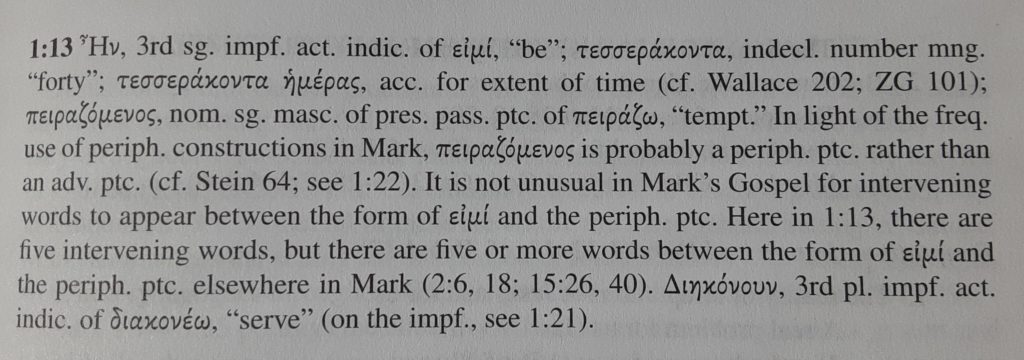The average exegete’s array of tools and equipment includes the Greek text, grammars, lexicons, and commentaries. Joel F. Williams has written Exegetical Guide to the Greek New Testament: Mark to help the exegete bridge those gaps that appear between Greek text and grammar or Greek text and commentary. A grammar may tell you what an “adverbial participle of concession” is, and even offer a few examples, but you may not be entirely sure if that’s what you’ve stumbled across in Mark 6:26 (108). A commentary might give explanations, theology, and background with little attention given to the Greek text. That’s what Williams is here for. He gives the Greek text the attention you crave. Having this book on your desk is kind of like having instant access to your Greek professor from seminary. It comes in handy. Not only for syntax, but also details lexical and textual. You will find some overlap into what you would expect to find in a traditional commentary, but I see this as a strength that makes this an excellent standalone resource to follow along with as you read a book in the Greek New Testament.
Here is an example of the typical analysis Williams provides for a verse, one I recently consulted for a sermon I’m currently preparing. (I’ve included the Greek text for the sake of convenience.)
καὶ ἦν ἐν τῇ ἐρήμῳ τεσσεράκοντα ἡμέρας πειραζόμενος ὑπὸ τοῦ σατανᾶ, καὶ ἦν μετὰ τῶν θηρίων, καὶ οἱ ἄγγελοι διηκόνουν αὐτῷ.

There are parsings for ἦν, τεσσεράκοντα, πειραζόμενος, and διηκόνουν. Williams also provides a couple of grammatical labels with some helpful references for anyone wishing to check out the grammars. The interpretive insight about Mark’s use of periphrastic constructions is helpful. Based on the analysis here, we would be less inclined to interpret this passage as stating Jesus was in the wilderness forty days while being tempted by Satan and more inclined to understand it as Jesus was being tempted by Satan in the wilderness for forty days.
As you can see, the parsings are redundant if you’re using Bible software, but the grammatical labels and insights are where we find the real value. Some of the other potentially useful stuff you’ll find in this book include extensive bibliographies of recommended resources for further study. There are Homiletical Suggestions where Williams hands you preaching outlines presumably driven by his analysis of the Greek text. Take for example this suggested outline for Mark 1:1–15 (27).
Let Me Introduce You to Jesus (1:1–15)
1. What do we learn about Jesus? (1:1–13)
- Jesus is God’s Messiah. (1:1)
- Jesus is the one promised by the prophets. (1:2–9)
- Jesus is the one loved by the Father and empowered by the Spirit (1:9–11)
- Jesus is the one who overpowers Satan. (1:12–13)
2. What do we learn about responding to Jesus? (1:14–15)
- Repent: Reorient your life toward Jesus. (1:15)
- Believe: Risk your life on Jesus. (1:15)
This book is filled with useful information for students and pastors. It won’t answer every question, but it’s a great place to look first when a question arises. My thoughts towards this book are overwhelmingly positive, but I will offer several points where I think it could be improved.
The first issue is the lack of a Greek text in the book. On the one hand, it requires the reader to look at their own Greek text, but on the other, this is less convenient. It’s worth noting that the Baylor Handbooks on the Greek Text do include the Greek text. Having used both, I definitely prefer Baylor’s inclusion of the text.
The second issue is a matter of organization. The abbreviations that appear in the analysis (temp., untr., vs., etc.) are in the same mix at the front of the book where you find all the other abbreviations for the book (USQR, VE, Yarbro Collins, etc.). These would be easier to reference if they were separate categories. But this isn’t a huge deal.
My third issue is a matter of textual coverage. Williams’s analysis ends with 16:8. Regardless of anyone’s position on the long ending textual variant of Mark, why not analyze those last twelve verses most people are going to see printed in their Bibles? (While we’re at it, I say throw in the “shorter ending” just for fun.) I appreciate the information that there’s an “awkward transition between 16:8 and 16:9” and a “distinctive vocabulary and unique uses of words in 16:9–20 when compared with the rest of Mark’s Gospel” (and even the referral to a relevant article by Elliott), but I wanted Williams to show me some of this analysis. And, what about those souls who subscribe to the long ending of Mark? (I know you’re out there.) It’s every preacher’s choice to preach it or not. A book on the Greek text of Mark should cover the longest textual variant in the New Testament.
Conclusion
I’ve found the Exegetical Guide to the Greek New Testament series from B&H Academic to be an incredibly valuable tool for exegesis. Joel F. Williams’s treatment of Mark for this series upholds the wonderful pedigree of this series. I recommend it to any preacher or student looking for help in better understanding the Greek text of the New Testament.
Special thanks to B&H Academic for providing me with a review copy of this book. This did not influence my thoughts regarding this work.
0 Comments